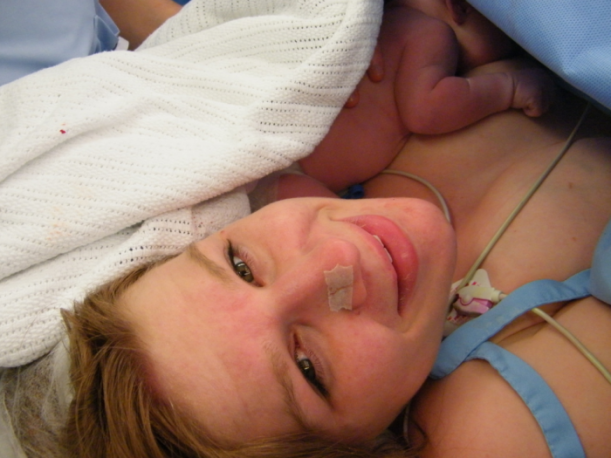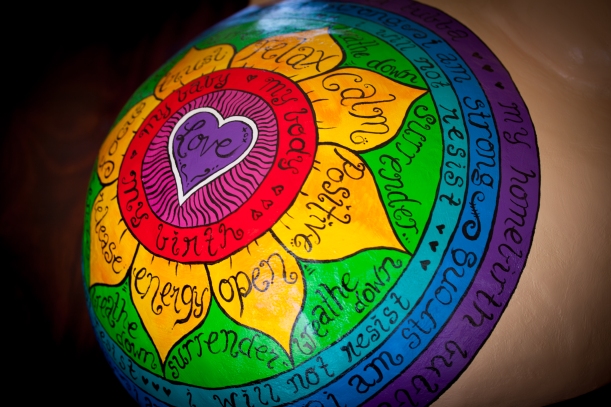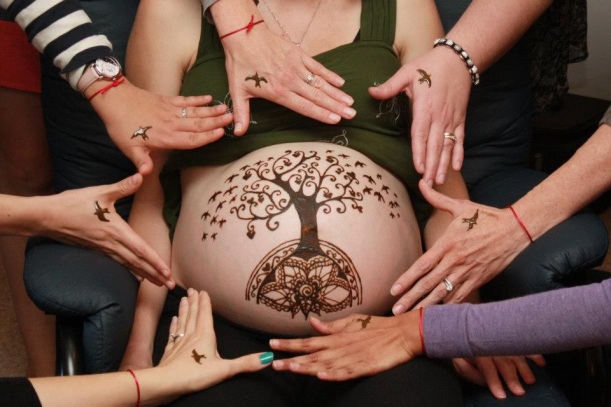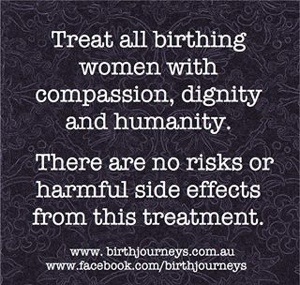The following editorial and story are take from Birth Journeys – positive birth stories to encourage and inspire. This is a series of excerpts from Natasha’s story of her journey through antenatal and postnatal depression and many other challenges. This story is found in the “Special Births” section of the Birth Journeys book. The introduction below is provided to allow readers to make an informed choice before they read this story (and any story in Birth Journeys). I am particularly grateful to Natasha for sharing her story so openly with us, as I believe it is very important for women to see that others face incredible challenges in pregnancy and they are not alone.
Introduction:
This powerful story follows Natasha’s journey through antenatal and postnatal depression, her husband’s alcoholism, her marriage breakdown, severe placenta praevia, pelvic instability and her physical and emotional violation by a health professional. Natasha is faced with so many challenges that they seem insurmountable. It is hard to imagine how there can be any positives.
Amidst all these troubles, Natasha decides that her second birth will be different. She wants to have a positive, powerful, intervention-free birth this time. She wants to feel present for the birth of her baby and to give her baby a safe and healthy entrance into the world. Birth is something Natasha feels she has some control over.
Natasha chooses one-to-one care with a trusted friend who is also a midwife. This relationship is so important in bringing Natasha through the challenges and helping her to achieve the birth she wants. Her faith in God gives Natasha the strength and hope that she will make it through.
In the end, Natasha has the positive and intervention-free birth she dreamt of, hoped for and planned for. This empowering experience is a beacon of light and a memory to hold onto in an otherwise dark and incredibly difficult time of Natasha’s life.
Positive Birth Story – Beacon of Light
The story of my second son’s birth is both positive and heartbreaking. It is intertwined with my journey through antenatal and postnatal depression and the breakdown of my marriage. The three are so woven together that it is impossible to tell one without telling the others.
We were living on a station in the desert area of Western Australia. The station was run as a tourism business doing cultural awareness training for mining companies, as well as running camps for schools and youth groups. I had wanted to fall pregnant for a few months, but it hadn’t happened. We decided that the timing wasn’t right and stopped trying. We were having huge problems with our marriage.
I had been feeling quite nauseous for a week or so and my period was overdue, but I had put it down to the emotions and stress of our marital problems. One morning, while my husband was in the shower, I wondered if maybe it was due to pregnancy.
I did the test, and when the two blue lines appeared, I began to cry. My husband had threatened to leave for the hundredth time the night before, and I had given him a last chance to make up his mind. Now I found myself pregnant. Needless to say, it wasn’t such a happy moment.
I opened the shower curtain and passed the test through to my husband. He was unresponsive. To this day I have no idea what was going through his head. Despite the circumstances leading up to the pregnancy, he decided to stay. His uncle stated it quite clearly when he said, “You can’t leave now. You are having another baby.”
***************
Placenta Praevia
After my 19 week checkup and scan my midwife rang to say that my scan showed a low lying placenta. I would need to come back into town the next week for a checkup with the local obstetrician.
I was so nervous. I looked up ‘low lying placenta’ and read all this horrible stuff about placenta praevia that left me feeling very distressed. When we went back for our checkup, the obstetrician (who had a very bad bedside manner and left me in tears!) did an internal scan. He said that my placenta was smack bang over the top of my cervix.
Even if it moved, it would never move enough for a vaginal birth. He told me it was classed as grade 4 placenta praevia. He said that from 26 weeks onwards, I wouldn’t be allowed to be more than five minutes from the hospital as I could haemorrhage at any time. He also told me that I would be having a caesarean. All of a sudden, my dream of a natural birth was snatched from me. I went home and cried.
The next couple of months were spent researching as much as I could about placenta praevia to see if there was anyway I could have input into the caesarean birth. I hoped I could opt to be awake rather than under a general anaesthetic. Unfortunately, due to the severity of the placenta praevia, this was unlikely to happen.
I went back to the obstetrician at 26 weeks for another checkup. He did the examination and said, “Well, this is impossible, but the placenta is nowhere in sight.”
To this day, I can’t explain it. It was a miracle! I have the print outs from both scans: one showing nothing but placenta, one showing nothing but baby’s head. A scan at 36 weeks showed that my placenta was at the top and front of my uterus. Again, impossible.
I was stoked! My plans for a natural birth were back on track. I rang my midwife and asked if I could get the notes from my previous birth. This was one of the best things I could have done in planning for my second birth.
I went over the notes with her, and now I understood the chain of events leading to my first birth. I had gone into hospital too early. I was only 3cm dilated when we arrived. I had been having contractions all night, but they weren’t very strong or close together. The midwife could have sent me home, but I think she recognised how tired and emotional I was after being up all night, and she admitted me instead.
My labour was labelled as a ‘failure to progress’ and the midwife ruptured my membranes. This led to intense contractions, one on top of the other, without any further dilation. The pain was greater than I could bear, so I had pethidine. I was so heavily drugged that I felt like I wasn’t there for the birth. Even now, there are some things I can’t remember.
Now I was able to go over the things I wanted to avoid this time around. I didn’t want to have my waters broken, I didn’t want any drugs offered and I wanted to stay at home for as long as possible. My midwife was completely onboard, and I was confident that any decisions she made would be in line with what I wanted. I trusted that intervention would only happen if it was truly necessary.
I had no fears about the birth. I was surrounded by stories of family who had birthed naturally, and I knew that with the right support, I would be able to have a natural birth this time. My body would do what it needed to. I know that things don’t always go according to plan with birthing, but to me the actual birth seemed to be the one thing that was within my control.
Antenatal Depression
The rest of my pregnancy was a blur of emotions. Between my failing marriage and depression, it was one of the hardest times of my life. My husband would often leave me out on the station alone for the weekend with our first son and no car while he went into town to drink. At first I loved the isolation, although looking back now, I would say this was the beginning of my antenatal depression.
I felt like I should be the happy, glowing pregnant mother, but I was far from it. I spent many nights crying, wondering how I would be able to look after my newborn baby when I could hardly look after myself. I felt nothing but impending doom. I was fearful, worried and scared that I wouldn’t be able to cope. I didn’t want to think about the baby inside of me. It was as if I tried to block it from my mind. There was no bonding with the baby, not in the beginning and not in the end.
When I was finally diagnosed with antenatal depression, I was relieved. Up to that point, I had been feeling foolish. How could I have postnatal depression when I hadn’t even had my baby yet? I hadn’t heard of antenatal depression before.
I was referred to counselling for antenatal depression and it helped immensely. My midwife made regular home visits (in the capacity of friend more than midwife), and I got extra support from my parents and my best friend.
***************
After the Birth
We stayed in the birthing room for around two hours before I finally had a shower and moved to the maternity room. This quiet time together was very important. Later, my parents came up to the hospital with our other son. He took to his brother straight away. He was calling him “My bebe” and didn’t want anyone else to hold him.
Even though much of my pregnancy and my baby’s first year of life has been lost in a blur of depression, I can clearly remember those first few happy hours. There were times during my pregnancy when I had felt so bleak and in the blackest hole. Reading my bible, praying, or attending church were completely out of the picture. Often I would just cry out, “God, help me!” and that would be enough to get me through the day. I held onto the faith that God would bring me through this. I truly believe that it was God’s strength that upheld me throughout my pregnancy.
We called our baby Hezekiah. It means ‘The Lord is my strength’.
I felt so proud after Hezekiah’s birth. I had been supported in my decisions for the birth and had managed to give birth without pain relief or intervention. I was completely present throughout the birth and not wiped out with drugs. I learnt that I could trust myself, my body and my ability to birth a baby.
I felt that even if the rest of my life was falling apart, I could share my birth story with others and be proud of it. My birth was the most positive birth I could ever have wished for, with a beautiful baby boy as a result. How could I not be proud of myself? During my dark moments, I clung to this like a person overboard clinging to a life buoy.
Read the rest of Natasha’s story in Birth Journeys.
Read other positive stories.
Read more about antenatal depression on the Positive Birth News blog here.
For information and support in Australia:
PANDA: http://www.panda.org.au/practical-information/about-postnatal-depression/27-antenatal-depression
Beyond Blue: http://www.beyondblue.org.au
Black Dog Institute: http://www.blackdoginstitute.org.au/public/depression/inpregnancypostnatal/babyblues.cfm

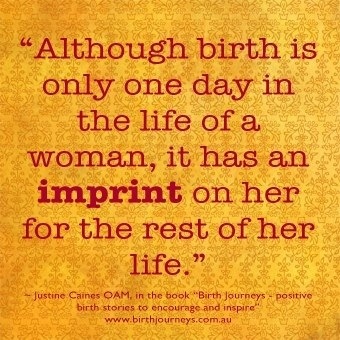
 “A Russian lawmaker has asked parliament to give women two days paid leave a month when they menstruate… Mikhail Degtyaryov, a member of the nationalist LDPR party, wrote on his website “During that period (of menstruation), most women experience psychological and physiological discomfort. The pain for the fair sex is often so intense that it is necessary to call an ambulance”… Scientists and gynecologists look on difficult menstruation not only as a medical, but also a social problem…” ~ Standard Digital, August 2013
“A Russian lawmaker has asked parliament to give women two days paid leave a month when they menstruate… Mikhail Degtyaryov, a member of the nationalist LDPR party, wrote on his website “During that period (of menstruation), most women experience psychological and physiological discomfort. The pain for the fair sex is often so intense that it is necessary to call an ambulance”… Scientists and gynecologists look on difficult menstruation not only as a medical, but also a social problem…” ~ Standard Digital, August 2013